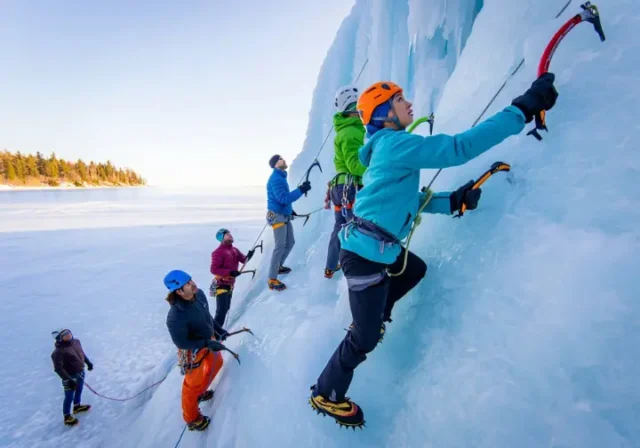In this article
Michigan’s Upper Peninsula, a region not typically associated with major ice climbing, has become an internationally recognized mecca for this unique winter sport. This guide will unveil why this “secret treasure” has gained global recognition, exploring the unique confluence of geology and climate that creates a premier Midwest destination. We will establish the Michigan Ice Fest as the cultural heart of the scene and provide a definitive planning tool for your next ice-climbing adventure.
The Allure of U.P. Ice: Geology, Climate, and Character
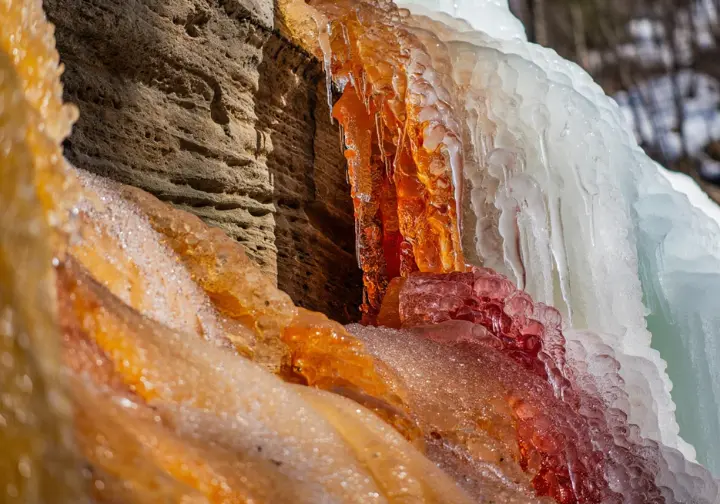
Delving into the foundational elements of Michigan’s Upper Peninsula reveals a unique and compelling ice climbing experience. We will explore the science behind the spectacular ice, the climate that sustains it, and the specific qualities that define the challenge and reward of climbing here in the winter.
The Geological Magic of Porous Sandstone
The area’s incredible ice formations are born from a core geological feature: the Munising Formation sandstone. This porous Cambrian rock acts like a giant sponge, absorbing groundwater year-round. As winter sets in, this water seeps directly through the cliff faces, freezing in place to form massive curtains and pillars. Unlike many climbing areas where ice forms only over distinct frozen waterfalls or icefalls, the sandstone’s permeability allows ice to form almost anywhere, creating a high density of routes.
The mineral-rich water seeping from the rock also stains the ice with vibrant colors—oranges, reds, and browns—making for a visually stunning and photogenic climbing experience. Understanding the geology of Pictured Rocks provides a deeper appreciation for the landscape. This process transforms Pictured Rocks into a vertical playground, much like how the unique Aztec Sandstone formations define another of the great rock climbing locations.
Lake Superior’s Formidable Influence
The powerful lake-effect climate generated by Lake Superior is the engine that drives the U.P. ice climbing season. The massive, relatively warm body of water provides a near-constant source of moisture and heavy snow to the frigid air during the Michigan winter. This results in the sustained cold needed for thick, stable ice formation. This climate creates both ideal conditions and significant hazards for any climber.
The lake’s proximity also creates the iconic experience of climbing directly above its open or frozen waters. This adds a level of exposure and psychological challenge not found in most inland climbing. A climber must be prepared to face extreme challenges due to harsh cold and wind chill, an element that defines the many winter activities at Pictured Rocks. Have you ever considered how a climb over a vast, frozen lake might change your mental game?
The Unique Character of “Michigan Ice”
The combination of consistent cold and lake-effect moisture creates ice with a distinct character, often described by experienced ice climbers as hard, dense, and sometimes brittle. This type of Michigan ice requires precise tool placements and confident footwork. It has led to the common saying, “If you can climb Michigan ice, you can climb anywhere,” highlighting how the conditions hone a climber’s technique.
Climbers must learn to adapt their swing and kicking technique to avoid fracturing the ice, making for a thoughtful experience. This challenge is a significant part of the area’s appeal, as Ice climbing requires specialized strength, endurance, and technique. Despite its hardness, the sheer abundance of beautiful climbs means there is something for everyone, from thick pillars to delicate, chandeliered features perfect for mixed climbing.
Your U.P. Climbing Atlas: A Guide to the Core Regions
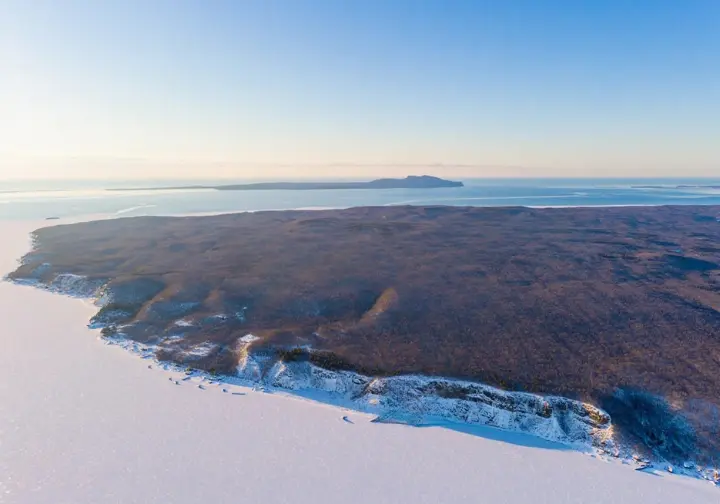
To help you decide where to focus your efforts, this detailed gazetteer breaks down the primary ice climbing areas in Northern Michigan. We will cover the character, access, and classic climbs of each area in the Upper Peninsula.
Pictured Rocks Frontcountry (Sand Point Road): The Epicenter of Access
The “Frontcountry” zone, accessed from Sand Point Road near Munising, is the most popular and concentrated climbing area in the U.P. It features dozens of ice flows and pillars from 20 to 60 feet high, all within a 5-to-30-minute hike. This accessible ice makes it the main venue for the Michigan Ice Fest’s clinics. It’s the perfect introduction to U.P. ice climbing.
Formations like “The Curtains” offer a wide wall of ice, and since Top rope climbing is an ideal introduction to the sport for beginners, this area is perfect for a beginner climber. More advanced climbers can test their skills on vertical pillars like “Sweet Mother Moses” or the iconic test piece, “The Dryer Hose.” The park service provides excellent resources for viewing ice formations near Sand Point.
Pictured Rocks Backcountry: The Adventurous Option
For those seeking solitude and wild backcountry ice, the Pictured Rocks backcountry offers a true wilderness experience. These remote routes require a 1-to-4-hour journey on skis or snow shoes along the unplowed Lakeshore Trail. This commitment filters out the crowds, rewarding self-sufficient parties with stunning climbs in a pristine setting.
Backcountry climbs are generally taller and more serious, often forming frozen fortresses on the 200-foot cliffs above Lake Superior. Iconic objectives include “Dairyland” (WI5), a magnificent 150-foot pillar. Climbing self-rescue skills are crucial for safety when professional rescue is unavailable, as cell service is non-existent. Preparedness is not optional for climbers on this peninsula.
Grand Island: Solitude and High-Stakes Access
Grand Island National Recreation Area, managed by the U.S. Forest Service, offers another distinct adventure. The island hosts impressive ice curtains similar in scale to the backcountry but with even greater solitude. The primary challenge is the access: a high-stakes crossing of the frozen channel of Lake Superior from Munising. The stability of the lake ice can change rapidly.
Because it is managed by the USFS, regulations may differ from the adjacent National Lakeshore. This focus on objective hazards connects with a broader understanding of environmental factors like rockfall and icefall requiring helmet use and cautious climbing practices. It is essential to understand the rules specific to this area before planning a trip to this part of Michigan.
The Keweenaw Peninsula: A Quieter Alternative
Located further north, the Keweenaw Peninsula provides a high-quality but less crowded ice climbing experience. The landscape, shaped by a historic copper mining boom, offers a different aesthetic and a collection of enjoyable climbs. It’s an excellent choice for climbers looking to escape the Munising crowds or for those on a multi-sport trip.
The most well-known area is Hungarian Falls, a series of frozen waterfalls near Hancock suitable for novices and intermediates. Conditions can be more variable than in Munising, so it’s crucial to check local beta. Be aware that some areas are on or near private property, requiring extra vigilance about access and ethics. This region offers a different flavor of climbing, just as a world-renowned bouldering destination offers a unique experience for year round climbers.
The Michigan Ice Fest: Heart of the Midwest Scene
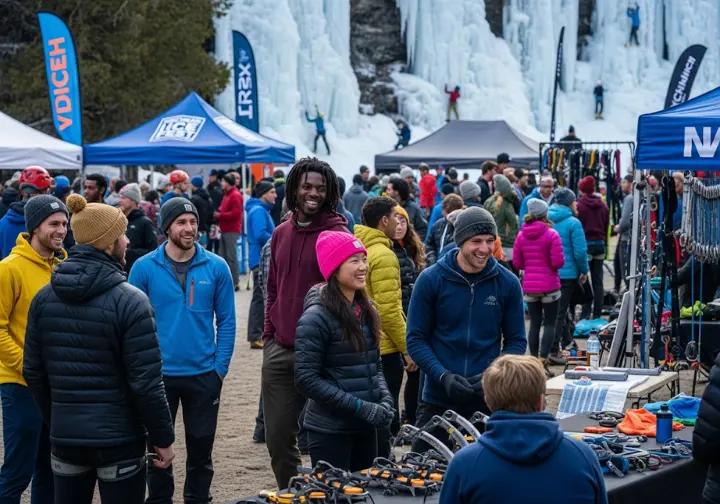
A deep dive into the Michigan Ice Fest reveals the single most important cultural event in the U.P. ice climbing scene. We’ll explore its rich history, its unique focus on beginners, and what you can expect from this vibrant, community-focused festival.
The History and Significance of the Fest
The Michigan Ice Fest has evolved from a small gathering in the early 1990s into one of the largest ice climbing festivals in the U.S. Its growth mirrors the U.P.’s transformation from a local secret to a global destination. A pivotal moment was Conrad Anker’s 2014 visit; his praise of the “top drawer ice climbing” by one of the world’s most famous climbers put Michigan on the international map.
Today, the annual Michigan Ice fest, organized by Bill Thompson of Michigan Ice Fest and the team at Down Wind Sports, is the primary driver of winter tourism in Munising. It brings together climbers, brands, and professional athletes. It has earned its place among the world’s best climbing festivals.
A Festival Built for the Beginner
A key differentiator of the Michigan Ice Fest is its unwavering focus on newcomers. An estimated 70% of attendees are new to the sport, from the true beginner climber to the avid gym climber looking to take their skills outdoors. This creates an exceptionally welcoming and supportive environment for learning. The festival provides an unparalleled opportunity to try the sport.
Participants in these beginner ice climbing classes get all necessary rental gear and, more importantly, receive instruction from world-class professional athletes. This focus on learning is what gives the festival its famous “family reunion” vibe. By removing barriers to entry, the event has built a tight-knit community, just as a good guide introduces rock climbing for beginners, emphasizing safety.
What to Expect: Clinics, Demos, and Community
A typical Michigan Ice Fest, held annually in mid-February, is a packed four-day event. Days are filled with on-ice instructional clinics for all skill levels, from “Intro to Ice” to advanced courses on lead climbing, mixed climbing, and self-rescue. A large gear demo area allows participants to try out the latest equipment. This is a great chance to learn about essential indoor climbing gear for beginners.
Evenings are a core part of the experience, with inspiring multimedia presentations from world-class climbers at Munising’s historic Mather Auditorium. Following the shows, nightly socials offer a chance to mingle with pros and share stories. You can find all the details on the official Michigan Ice Fest website. This blend of learning and community makes the festival so memorable.
The Definitive Trip Planner: Logistics for Your U.P. Adventure
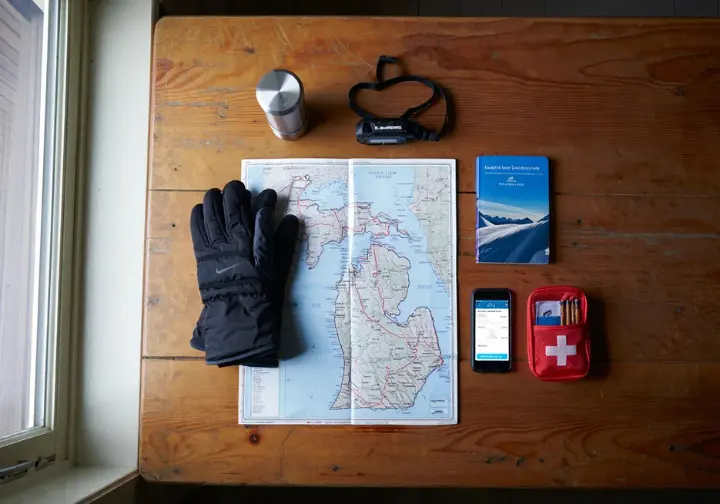
Planning and executing a successful ice climbing trip to Munising requires critical logistical information. Our functional toolkit provides informative ice climbing beta and covers everything from timing and travel to lodging and gear.
When to Go and How to Get There
The U.P. ice climbing season in Munising typically runs from mid-December through late March. The Michigan Ice Fest in mid-February is the most popular time to visit. Munising is remote; most visitors drive. The closest major airports are in Marquette (MQT), a 45-minute drive, or Escanaba (ESC), about an hour away.
For the popular frontcountry area, parking is at the Sand Point Beach lot. There is absolutely no parking allowed on the narrow shoulder of Sand Point Road; this is strictly enforced. During the Ice Fest, a free shuttle runs from town to the climbing areas. Just as with other destinations, planning around the best climbing seasons is key to a successful trip.
Finding Your Basecamp: Where to Stay
Munising is the primary base for climbers and offers various lodging options. It’s highly recommended to book accommodations well in advance, especially during the Ice Fest, as the town fills up. The Ice Fest website maintains a curated official festival lodging list.
Options range from standard hotels and motels like the Holiday Inn Express to rental cabins and bed & breakfasts. Many are accustomed to catering to climbers and snowmobilers. These can offer more space and amenities like kitchens, which is convenient for longer stays. The local visitor’s bureau also lists many lodging options in Munising.
Guided Trips and Essential Gear
For those new to the sport or seeking expert guidance, a guided climb is the best option. Down Wind Sports is the primary local guide service, offering courses from a three-hour intro to full-day backcountry adventures. Their guides have intimate knowledge of the area. You can find more details on the official Pictured Rocks guided climbing information page.
Down Wind Sports is also the main source for gear rentals. If bringing your own gear, essentials include a helmet, warm mountaineering boots, crampons, ice tools, a harness, and a belay device. For leading, a 60-70m rope and 10-15 ice screws are standard. Knowing your essential gear, techniques, and safety considerations before you arrive is always a good idea.
Safety First: Navigating U.P. Ice and Regulations
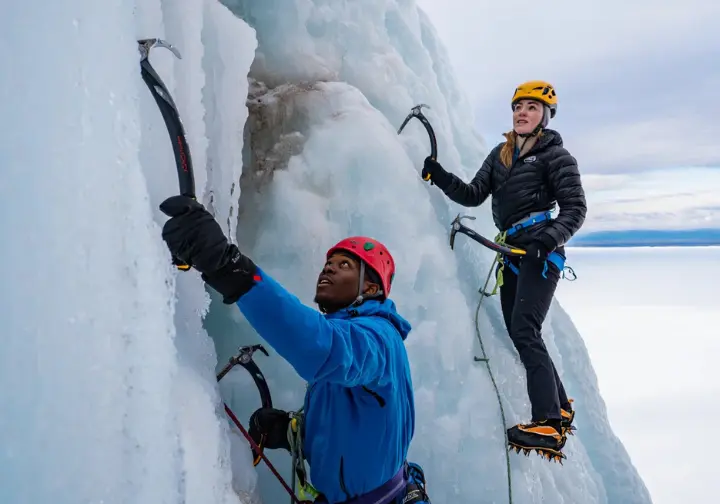
Staying safe and climbing responsibly are the most critical aspects of a U.P. ice trip. We will cover the specific objective hazards of the environment, how to get reliable information, and the official rules you must follow to enjoy ice climbing in Michigan safely.
Objective Hazards: Lake Superior, Falling Ice, and Cold
Ice climbing in the U.P. carries inherent risks. The primary objective hazard is the environment, dominated by Lake Superior. Extreme cold and high winds can lead to hypothermia and frostbite. Falling ice is a constant threat from natural cycles and other climbers above you; helmets are non-negotiable. The porous sandstone can also be unstable at the cliff edge, so build anchors well back.
For backcountry and Grand Island climbs, the lake itself is a major hazard. Lake ice stability can never be guaranteed, and rescue is difficult and often delayed. This reinforces the need for experience and self-sufficiency. These multiple, overlapping risks are a perfect illustration of The Swiss Cheese Model of accident causation, where layers of defense are critical.
Getting the Beta: How to Check Ice Conditions
Ice conditions are dynamic and can change hourly. The success and safety of your trip depend on getting reliable, up-to-the-minute “beta.” It is never safe to assume a route is in good condition just because it was last week. What is your process for gathering last-minute intel before heading out to climb?
There are two primary sources for U.P. ice conditions. The Michigan Ice Fest website posts periodic reports. However, the most reliable method for current beta is to call Down Wind Sports directly at (906) 387-8025. Their staff are on the ice daily and can provide the most accurate assessment of what is safe and what should be avoided. This call should be a mandatory step before any climbing day.
Know Before You Go: NPS vs. USFS Rules
Climbing in the Munising area occurs on land managed by two federal agencies: the National Park Service (NPS) and the US Forest Service (USFS). It is your responsibility to know and follow the specific rules. Always check the official Pictured Rocks ice climbing regulations before your trip.
In Pictured Rocks (NPS), the iconic Munising Falls is permanently closed to all climbing. Pets are not permitted on trails to the Sand Point climbing areas, and camping is prohibited at the climbing sites. As of 2022, Pictured Rocks requires an entrance fee. Adhering to these rules and the broader Leave No Trace (LNT) framework ensures our continued privilege to climb in this spectacular park.
Conclusion: Your U.P. Ice Adventure Awaits
Michigan’s Upper Peninsula, powered by its unique geology and lake-effect climate, offers a truly world-class ice climbing experience that is surprisingly accessible and the best in the American Midwest. The Michigan Ice Fest is its cultural hub, providing an incredibly welcoming environment for beginners to learn and for seasoned climbers to reconnect. A successful trip hinges on planning, checking conditions by calling local experts, and following land manager regulations. Whether you’re taking your first swings at “The Curtains” or tackling a remote test piece like “Dairyland,” the U.P. offers a complete spectrum of adventure for any dedicated climber.
Frequently Asked Questions about Ice Climbing in Michigan
Is Michigan good for beginner ice climbers? +
What is the best month for ice climbing in Michigan’s U.P.? +
Can I climb the big, famous waterfall in the town of Munising? +
What is the most famous ice climb in Michigan? +
Risk Disclaimer: Rock climbing, mountaineering, and all related activities are inherently dangerous sports that can result in serious injury or death. The information provided on Rock Climbing Realms is for educational and informational purposes only. While we strive for accuracy, the information, techniques, and advice presented on this website are not a substitute for professional, hands-on instruction or your own best judgment. Conditions and risks can vary. Never attempt a new technique based solely on information read here. Always seek guidance from a qualified instructor. By using this website, you agree that you are solely responsible for your own safety. Any reliance you place on this information is therefore strictly at your own risk, and you assume all liability for your actions. Rock Climbing Realms and its authors will not be held liable for any injury, damage, or loss sustained in connection with the use of the information contained herein.
Affiliate Disclosure: We are a participant in the Amazon Services LLC Associates Program, an affiliate advertising program designed to provide a means for us to earn advertising fees by advertising and linking to Amazon.com. As an Amazon Associate, we earn from qualifying purchases. We also participate in other affiliate programs. Additional terms are found in the terms of service.


